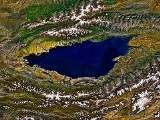
Issyk Kul
Encyclopedia
Issyk Kul is an endorheic
lake
in the northern Tian Shan
mountains in eastern Kyrgyzstan
. It is the tenth largest lake in the world by volume and the second largest saline lake after the Caspian Sea
. Although it is surrounded by snow-capped peaks, it never freezes; hence its name, which means "hot lake" in the Kyrgyz language
. The lake is a Ramsar
site of globally significant biodiversity
(Ramsar Site RDB Code 2KG001) and forms part of the Issyk-Kul Biosphere Reserve. It is also the site of an ancient metropolis 2500 years ago, and archaeological excavations are ongoing.
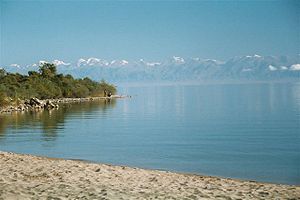
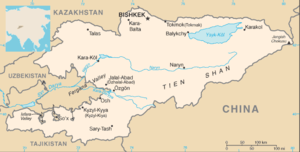 Lake Issyk Kul has a length of 182 kilometres (113.1 mi), a width of up to 60 kilometres (37.3 mi), and covers an area of 6236 square kilometres (2,407.7 sq mi). This makes it the second largest mountain lake in the world behind Lake Titicaca
Lake Issyk Kul has a length of 182 kilometres (113.1 mi), a width of up to 60 kilometres (37.3 mi), and covers an area of 6236 square kilometres (2,407.7 sq mi). This makes it the second largest mountain lake in the world behind Lake Titicaca
in South America
. Located at an altitude of 1607 metres (5,272.3 ft), it reaches 668 metres (2,191.6 ft) in depth.
About 118 rivers and streams flow into the lake; the largest are the Djyrgalan and Tyup. It is fed by springs, including many hot springs
, and snow melt-off. The lake has no current outlet, but some hydrologists hypothesize that, deep underground, lake water filters into the Chu River
. The bottom of the lake contains the mineral monohydrocalcite
: one of the few known lacustrine
deposits.
The lake's southern shore is dominated by the ruggedly beautiful Teskey Ala-Too Range
of the Tian Shan
mountains.
The Kyungey Ala-Too of the Tian Shan
runs parallel to the north shore.
The lake water has salinity
of approx. 0.6%—compare to 3.5% salinity of typical seawater
—and its level drops by approximately 5 cm per year.
Administratively, the lake and the adjacent land are within Issyk Kul Province
of Kyrgyzstan.
era, the lake became a popular vacation resort, with numerous sanatoria
, boarding houses and vacation homes along its northern shore, many concentrated in and around the town of Cholpon-Ata
. These fell on hard times after the break-up of the USSR, but now hotel complexes are being refurbished and simple private bed-and-breakfast pensions are being established for a new generation of health and leisure visitors.
The city of Karakol
(formerly Przhevalsk, after the Russia
n explorer Przhevalsky who died there) is the administrative seat of Issyk Kul Province
of Kyrgyzstan. It is located near the eastern tip of the lake and is a good base for excursions into the surrounding area. Its small old core contains an impressive wooden mosque
, built without metal nails by the Dungan people, and a wooden Orthodox
church that was used as a stable during Soviet times (see state atheism
).
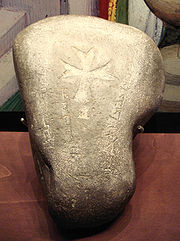 Lake Issyk Kul was a stopover on the Silk Road
Lake Issyk Kul was a stopover on the Silk Road
, a land route for travelers from the Far East to Europe. Many historians believe that the lake was the point of origin for the Black Death
that plagued Europe
and Asia
during the early and mid-14th century. The lake's status as a byway for travelers allowed the plague to spread across these continents via medieval merchants who unknowingly carried infested vermin
along with them. A 14th century Armenian monastery
was found on the northeastern shores of the lake by retracing the steps of a medieval map used by Venetian
merchants on the Silk Road
.
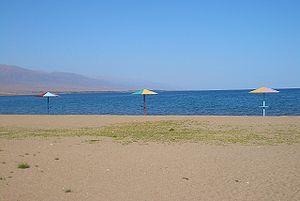 The lake level was some 8 metres (26.2 ft) lower in medieval times. Divers have found the remains of submerged settlements in shallow areas around the lake. In December 2007, a report was released by a team of Kyrgyz historians, led by Vladimir Ploskikh, vice president of the Kyrgyz Academy of Sciences
The lake level was some 8 metres (26.2 ft) lower in medieval times. Divers have found the remains of submerged settlements in shallow areas around the lake. In December 2007, a report was released by a team of Kyrgyz historians, led by Vladimir Ploskikh, vice president of the Kyrgyz Academy of Sciences
, that archaeologists have discovered the remains of a 2500-year-old advanced civilization at the bottom of the Lake.
The data and artifacts obtained suggest that the ancient city was a metropolis in its time.
The discovery consisted of formidable walls, some stretching for 500 metres (1,640.4 ft) as well as traces of a large city with an area of several square kilometers.
Other findings included Scythian burial mounds eroded over the centuries by waves, as well as numerous well-preserved artifacts, including bronze battleaxes, arrowheads, self-sharpening daggers, objects discarded by smiths, casting molds, and a faceted gold bar that was a monetary unit of the time.
Articles identified as the world's oldest extant coins were also found underwater with gold wire rings used as small change and a large hexahedral goldpiece. Also found was a bronze cauldron
with a level of craftsmanship that is today achieved by using an inert gas
environment.
In 1916 the monastery at Issyk Kul was attacked by Kyrgyz rebels, seven monks were killed

(Leuciscus schmidti), Issyk-Kul Dace
(Leuciscus bergi), Marinka (Schizothorax issyk-kuli), and Sheer or Naked Osman (Diptychus
dybovskii). Seven other endemic species are almost certainly threatened as by-catch or are indirectly impacted by fishing activity and changes to the structure and balance of the lake's fish population.
Sevan trout
, a fish endemic
to Lake Sevan
in Armenia
, was introduced into Issyk-Kul in the 1970s. While this fish
is an endangered species
in its "home" lake, it has a much better chance to survive in Lake Issyk-Kul where it has ravaged the indigenous species.
ic legend, the king of the Ossounes had donkey's ears. He would hide them, and order each of his barbers killed to hide his secret. One barber yelled the secret into a well, but he did not cover the well after. The well water rose and flooded the kingdom. The kingdom is today under the waters of Issyk-Kul. This is how the lake was formed, according to the legend. Other legends say that four drowned cities lie at the bottom of the lake. Substantial archaeological finds indicating the presence of an advanced civilization in ancient times have been made in shallow waters of the lake.
operated an extensive facility at the lake's eastern end, where submarine and torpedo technology was evaluated. In March 2008, Kyrgyz newspapers reported that 866 hectares (2,139.9 acre) around the Karabulan Peninsula on the lake would be leased for an indefinite period to the Russian Navy, which is planning to establish new naval testing facilities as part of the 2007 bilateral Agreement on Friendship, Cooperation, Mutual Help, and Protection of Secret Materials. The Russian military will pay $4.5 million annually to lease the area. India
also plans to invest in the facility to test all types of torpedoes such as heavy weight torpedoes and those that have thermal navigation system. Another advantage that works for the testing center is that the torpedoes fired can also be recovered allowing scientists to make physical verification of a torpedo structure for further study. India is also planning to use the torpedo test facility to test the Autonomous Underwater Vehicle
being developed by NSTL
. For this India
has proposed to engage local companies with know-how in torpedo technology to further co-develop the facility.
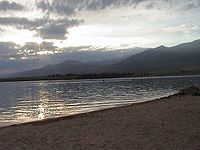
Endorheic
An endorheic basin is a closed drainage basin that retains water and allows no outflow to other bodies of water such as rivers or oceans...
lake
Lake
A lake is a body of relatively still fresh or salt water of considerable size, localized in a basin, that is surrounded by land. Lakes are inland and not part of the ocean and therefore are distinct from lagoons, and are larger and deeper than ponds. Lakes can be contrasted with rivers or streams,...
in the northern Tian Shan
Tian Shan
The Tian Shan , also spelled Tien Shan, is a large mountain system located in Central Asia. The highest peak in the Tian Shan is Victory Peak , ....
mountains in eastern Kyrgyzstan
Kyrgyzstan
Kyrgyzstan , officially the Kyrgyz Republic is one of the world's six independent Turkic states . Located in Central Asia, landlocked and mountainous, Kyrgyzstan is bordered by Kazakhstan to the north, Uzbekistan to the west, Tajikistan to the southwest and China to the east...
. It is the tenth largest lake in the world by volume and the second largest saline lake after the Caspian Sea
Caspian Sea
The Caspian Sea is the largest enclosed body of water on Earth by area, variously classed as the world's largest lake or a full-fledged sea. The sea has a surface area of and a volume of...
. Although it is surrounded by snow-capped peaks, it never freezes; hence its name, which means "hot lake" in the Kyrgyz language
Kyrgyz language
Kyrgyz or Kirgiz, also Kirghiz, Kyrghiz, Qyrghiz is a Turkic language and, together with Russian, an official language of Kyrgyzstan...
. The lake is a Ramsar
Ramsar Convention
The Ramsar Convention is an international treaty for the conservation and sustainable utilization of wetlands, i.e., to stem the progressive encroachment on and loss of wetlands now and in the future, recognizing the fundamental ecological functions of wetlands and their economic, cultural,...
site of globally significant biodiversity
Biodiversity
Biodiversity is the degree of variation of life forms within a given ecosystem, biome, or an entire planet. Biodiversity is a measure of the health of ecosystems. Biodiversity is in part a function of climate. In terrestrial habitats, tropical regions are typically rich whereas polar regions...
(Ramsar Site RDB Code 2KG001) and forms part of the Issyk-Kul Biosphere Reserve. It is also the site of an ancient metropolis 2500 years ago, and archaeological excavations are ongoing.
Geography


Lake Titicaca
Lake Titicaca is a lake located on the border of Peru and Bolivia. It sits 3,811 m above sea level, making it the highest commercially navigable lake in the world...
in South America
South America
South America is a continent situated in the Western Hemisphere, mostly in the Southern Hemisphere, with a relatively small portion in the Northern Hemisphere. The continent is also considered a subcontinent of the Americas. It is bordered on the west by the Pacific Ocean and on the north and east...
. Located at an altitude of 1607 metres (5,272.3 ft), it reaches 668 metres (2,191.6 ft) in depth.
About 118 rivers and streams flow into the lake; the largest are the Djyrgalan and Tyup. It is fed by springs, including many hot springs
Hot Springs
Hot Springs may refer to:* Hot Springs, Arkansas** Hot Springs National Park, Arkansas*Hot Springs, California**Hot Springs, Lassen County, California**Hot Springs, Modoc County, California**Hot Springs, Placer County, California...
, and snow melt-off. The lake has no current outlet, but some hydrologists hypothesize that, deep underground, lake water filters into the Chu River
Chu River
"Chui River" redirects here. For the South American Chuí or Chuy River, on the Brazil-Uruguay border and Brazil's southernmost point, see Chuí River. For the Nam Sam River or Chu River, on the Lao-Vietnam border, see Nam Sam River....
. The bottom of the lake contains the mineral monohydrocalcite
Monohydrocalcite
Monohydrocalcite is a mineral that is a hydrous form of calcium carbonate, CaCO3·H2O. It was formerly also known by the name hydrocalcite, which is now discredited by the IMA. It is a trigonal mineral which is white when pure...
: one of the few known lacustrine
Lacustrine
Lacustrine means "of a lake" or "relating to a lake".Specifically, it may refer to:*Lacustrine plain*Lacustrine delta-Fish:*Lacustrine goby , a type of small fish found in Philippine waters belonging to the Gobiidae family, known in Tagalog as dulong-See also:*Fluvial - of or relating a...
deposits.
The lake's southern shore is dominated by the ruggedly beautiful Teskey Ala-Too Range
Teskey Ala-Too Range
The Teskey Ala-Too or Terskey Ala-Too is a mountain range in Kyrgyzstan's Tien-Shan that borders Issyk Kul and Kochkor Valley from the south. The length of the range is 354 km and highest peak -Yeltsin Peak...
of the Tian Shan
Tian Shan
The Tian Shan , also spelled Tien Shan, is a large mountain system located in Central Asia. The highest peak in the Tian Shan is Victory Peak , ....
mountains.
The Kyungey Ala-Too of the Tian Shan
Tian Shan
The Tian Shan , also spelled Tien Shan, is a large mountain system located in Central Asia. The highest peak in the Tian Shan is Victory Peak , ....
runs parallel to the north shore.
The lake water has salinity
Salinity
Salinity is the saltiness or dissolved salt content of a body of water. It is a general term used to describe the levels of different salts such as sodium chloride, magnesium and calcium sulfates, and bicarbonates...
of approx. 0.6%—compare to 3.5% salinity of typical seawater
Seawater
Seawater is water from a sea or ocean. On average, seawater in the world's oceans has a salinity of about 3.5% . This means that every kilogram of seawater has approximately of dissolved salts . The average density of seawater at the ocean surface is 1.025 g/ml...
—and its level drops by approximately 5 cm per year.
Administratively, the lake and the adjacent land are within Issyk Kul Province
Issyk Kul Province
Issyk Kul Province is a province of Kyrgyzstan. Its capital is Karakol. It is surrounded by Almaty Province, Kazakhstan , Chui Province , Naryn Province and Xinjiang, China ....
of Kyrgyzstan.
Tourism
During the SovietSoviet Union
The Soviet Union , officially the Union of Soviet Socialist Republics , was a constitutionally socialist state that existed in Eurasia between 1922 and 1991....
era, the lake became a popular vacation resort, with numerous sanatoria
Sanatorium
A sanatorium is a medical facility for long-term illness, most typically associated with treatment of tuberculosis before antibiotics...
, boarding houses and vacation homes along its northern shore, many concentrated in and around the town of Cholpon-Ata
Cholpon-Ata
Cholpon-Ata is a resort town on the northern shore of Lake Issyk-Kul in Kyrgyzstan with a year-round population of about 12,000. It is the administrative center of the Issyk Kul District of Issyk Kul Province; this district occupies most of the lake's north shore...
. These fell on hard times after the break-up of the USSR, but now hotel complexes are being refurbished and simple private bed-and-breakfast pensions are being established for a new generation of health and leisure visitors.
The city of Karakol
Karakol
Karakol , formerly Przhevalsk, is fourth largest city in Kyrgyzstan, near the eastern tip of Issyk Kul Lake in Kyrgyzstan, about from the Kyrgyzstan-China border and from the capital Bishkek. It is the administrative capital of Issyk Kul Province...
(formerly Przhevalsk, after the Russia
Russia
Russia or , officially known as both Russia and the Russian Federation , is a country in northern Eurasia. It is a federal semi-presidential republic, comprising 83 federal subjects...
n explorer Przhevalsky who died there) is the administrative seat of Issyk Kul Province
Issyk Kul Province
Issyk Kul Province is a province of Kyrgyzstan. Its capital is Karakol. It is surrounded by Almaty Province, Kazakhstan , Chui Province , Naryn Province and Xinjiang, China ....
of Kyrgyzstan. It is located near the eastern tip of the lake and is a good base for excursions into the surrounding area. Its small old core contains an impressive wooden mosque
Mosque
A mosque is a place of worship for followers of Islam. The word is likely to have entered the English language through French , from Portuguese , from Spanish , and from Berber , ultimately originating in — . The Arabic word masjid literally means a place of prostration...
, built without metal nails by the Dungan people, and a wooden Orthodox
Eastern Orthodox Church
The Orthodox Church, officially called the Orthodox Catholic Church and commonly referred to as the Eastern Orthodox Church, is the second largest Christian denomination in the world, with an estimated 300 million adherents mainly in the countries of Belarus, Bulgaria, Cyprus, Georgia, Greece,...
church that was used as a stable during Soviet times (see state atheism
State atheism
State atheism is the official "promotion of atheism" by a government, sometimes combined with active suppression of religious freedom and practice...
).
History

Silk Road
The Silk Road or Silk Route refers to a historical network of interlinking trade routes across the Afro-Eurasian landmass that connected East, South, and Western Asia with the Mediterranean and European world, as well as parts of North and East Africa...
, a land route for travelers from the Far East to Europe. Many historians believe that the lake was the point of origin for the Black Death
Black Death
The Black Death was one of the most devastating pandemics in human history, peaking in Europe between 1348 and 1350. Of several competing theories, the dominant explanation for the Black Death is the plague theory, which attributes the outbreak to the bacterium Yersinia pestis. Thought to have...
that plagued Europe
Europe
Europe is, by convention, one of the world's seven continents. Comprising the westernmost peninsula of Eurasia, Europe is generally 'divided' from Asia to its east by the watershed divides of the Ural and Caucasus Mountains, the Ural River, the Caspian and Black Seas, and the waterways connecting...
and Asia
Asia
Asia is the world's largest and most populous continent, located primarily in the eastern and northern hemispheres. It covers 8.7% of the Earth's total surface area and with approximately 3.879 billion people, it hosts 60% of the world's current human population...
during the early and mid-14th century. The lake's status as a byway for travelers allowed the plague to spread across these continents via medieval merchants who unknowingly carried infested vermin
Vermin
Vermin is a term applied to various animal species regarded by some as pests or nuisances and especially to those associated with the carrying of disease. Since the term is defined in relation to human activities, which species are included will vary from area to area and even person to person...
along with them. A 14th century Armenian monastery
Monastery
Monastery denotes the building, or complex of buildings, that houses a room reserved for prayer as well as the domestic quarters and workplace of monastics, whether monks or nuns, and whether living in community or alone .Monasteries may vary greatly in size – a small dwelling accommodating only...
was found on the northeastern shores of the lake by retracing the steps of a medieval map used by Venetian
Venice
Venice is a city in northern Italy which is renowned for the beauty of its setting, its architecture and its artworks. It is the capital of the Veneto region...
merchants on the Silk Road
Silk Road
The Silk Road or Silk Route refers to a historical network of interlinking trade routes across the Afro-Eurasian landmass that connected East, South, and Western Asia with the Mediterranean and European world, as well as parts of North and East Africa...
.

Kyrgyz Academy of Sciences
Kyrgyz Academy of Sciences , originally part of the Soviet Academy of Sciences, was established as an independent entity by government decree in December 1993...
, that archaeologists have discovered the remains of a 2500-year-old advanced civilization at the bottom of the Lake.
The data and artifacts obtained suggest that the ancient city was a metropolis in its time.
The discovery consisted of formidable walls, some stretching for 500 metres (1,640.4 ft) as well as traces of a large city with an area of several square kilometers.
Other findings included Scythian burial mounds eroded over the centuries by waves, as well as numerous well-preserved artifacts, including bronze battleaxes, arrowheads, self-sharpening daggers, objects discarded by smiths, casting molds, and a faceted gold bar that was a monetary unit of the time.
Articles identified as the world's oldest extant coins were also found underwater with gold wire rings used as small change and a large hexahedral goldpiece. Also found was a bronze cauldron
Cauldron
A cauldron or caldron is a large metal pot for cooking and/or boiling over an open fire, with a large mouth and frequently with an arc-shaped hanger.- Etymology :...
with a level of craftsmanship that is today achieved by using an inert gas
Inert gas
An inert gas is a non-reactive gas used during chemical synthesis, chemical analysis, or preservation of reactive materials. Inert gases are selected for specific settings for which they are functionally inert since the cost of the gas and the cost of purifying the gas are usually a consideration...
environment.
In 1916 the monastery at Issyk Kul was attacked by Kyrgyz rebels, seven monks were killed

Fish
The lake contains highly endemic fish biodiversity, and some of the species, including four endemics, are seriously endangered. In recent years catches of all species of fish have declined markedly, due to a combination of over-fishing, heavy predation by two of the introduced species, and the cessation of lake restocking with juvenile fish from hatcheries. At least four commercially targeted endemic fish species are sufficiently threatened to be included in the Red Book of the Kyrgyz Republic: Schmidt's DaceSchmidt's Dace
Schmidt's Dace is a species of ray-finned fish in the genus Leuciscus....
(Leuciscus schmidti), Issyk-Kul Dace
Issyk-Kul Dace
Issyk-Kul Dace is a species of ray-finned fish in the genus Leuciscus....
(Leuciscus bergi), Marinka (Schizothorax issyk-kuli), and Sheer or Naked Osman (Diptychus
Diptychus
Diptychus is a genus of cyprinid fish, consisting of two Asian species. The type species is the scaly osman, Diptychus maculatus. The name is derived from the Greek word di, meaning "two", and the Greek word ptyx, meaning "fold".-Species:...
dybovskii). Seven other endemic species are almost certainly threatened as by-catch or are indirectly impacted by fishing activity and changes to the structure and balance of the lake's fish population.
Sevan trout
Sevan trout
The Sevan trout is an endemic fish species of Lake Sevan in Armenia. It is a salmonid fish related to the brown trout....
, a fish endemic
Endemic (ecology)
Endemism is the ecological state of being unique to a defined geographic location, such as an island, nation or other defined zone, or habitat type; organisms that are indigenous to a place are not endemic to it if they are also found elsewhere. For example, all species of lemur are endemic to the...
to Lake Sevan
Lake Sevan
Lake Sevan is the largest lake in Armenia and the Caucasus region. It is one of the largest high-altitude lakes in the world.Lake Sevan is situated in the central part of the Republic of Armenia, inside the Gegharkunik Province, at the altitude of 1,900m above sea level...
in Armenia
Armenia
Armenia , officially the Republic of Armenia , is a landlocked mountainous country in the Caucasus region of Eurasia...
, was introduced into Issyk-Kul in the 1970s. While this fish
Fish
Fish are a paraphyletic group of organisms that consist of all gill-bearing aquatic vertebrate animals that lack limbs with digits. Included in this definition are the living hagfish, lampreys, and cartilaginous and bony fish, as well as various extinct related groups...
is an endangered species
Endangered species
An endangered species is a population of organisms which is at risk of becoming extinct because it is either few in numbers, or threatened by changing environmental or predation parameters...
in its "home" lake, it has a much better chance to survive in Lake Issyk-Kul where it has ravaged the indigenous species.
Creation legend
In pre-IslamIslam
Islam . The most common are and . : Arabic pronunciation varies regionally. The first vowel ranges from ~~. The second vowel ranges from ~~~...
ic legend, the king of the Ossounes had donkey's ears. He would hide them, and order each of his barbers killed to hide his secret. One barber yelled the secret into a well, but he did not cover the well after. The well water rose and flooded the kingdom. The kingdom is today under the waters of Issyk-Kul. This is how the lake was formed, according to the legend. Other legends say that four drowned cities lie at the bottom of the lake. Substantial archaeological finds indicating the presence of an advanced civilization in ancient times have been made in shallow waters of the lake.
Russian Navy test site
During the Soviet period, the Soviet NavySoviet Navy
The Soviet Navy was the naval arm of the Soviet Armed Forces. Often referred to as the Red Fleet, the Soviet Navy would have played an instrumental role in a Warsaw Pact war with NATO, where it would have attempted to prevent naval convoys from bringing reinforcements across the Atlantic Ocean...
operated an extensive facility at the lake's eastern end, where submarine and torpedo technology was evaluated. In March 2008, Kyrgyz newspapers reported that 866 hectares (2,139.9 acre) around the Karabulan Peninsula on the lake would be leased for an indefinite period to the Russian Navy, which is planning to establish new naval testing facilities as part of the 2007 bilateral Agreement on Friendship, Cooperation, Mutual Help, and Protection of Secret Materials. The Russian military will pay $4.5 million annually to lease the area. India
India
India , officially the Republic of India , is a country in South Asia. It is the seventh-largest country by geographical area, the second-most populous country with over 1.2 billion people, and the most populous democracy in the world...
also plans to invest in the facility to test all types of torpedoes such as heavy weight torpedoes and those that have thermal navigation system. Another advantage that works for the testing center is that the torpedoes fired can also be recovered allowing scientists to make physical verification of a torpedo structure for further study. India is also planning to use the torpedo test facility to test the Autonomous Underwater Vehicle
Autonomous Underwater Vehicle
An autonomous underwater vehicle is a robot which travels underwater without requiring input from an operator. AUVs constitute part of a larger group of undersea systems known as unmanned underwater vehicles, a classification that includes non-autonomous remotely operated underwater vehicles...
being developed by NSTL
NSTL
NSTL refers to the*National Software Testing Laboratories in Blue Bell, Pennsylvania*National Soil Tilth Laboratory in Ames, Iowa*former National Space Technology Laboratory, now John C...
. For this India
India
India , officially the Republic of India , is a country in South Asia. It is the seventh-largest country by geographical area, the second-most populous country with over 1.2 billion people, and the most populous democracy in the world...
has proposed to engage local companies with know-how in torpedo technology to further co-develop the facility.

Lakeside towns
Towns and some villages around the lake, listed clockwise from the lake's western tip:- BalykchyBalykchyBalykchy is a town with a population about 40,000 people located at the western end of Lake Issyk-Kul in Kyrgyzstan, at and an elevation of about 1,900 metres...
(the railhead at the western end of the lake) - Koshkol'Koshkol'Koshkol is a village in the Issyk Kul Province of Kyrgyzstan. The village name has also been transliterated as Kosh-Kël' or Kosh-Kel'.It is located in the Issyk Kul District of this province, near the northern shore of Lake Issyk Kul between Balykchy and Cholpon-Ata. The village includes two...
- TamchyTamchyTamchy is a village in the Issyk Kul District of the Issyk Kul Province of Kyrgyzstan. The name used to be transcribed into English as Tamchi, and some local road signs have it, surprisingly, as Tamczy....
- Cholpon-AtaCholpon-AtaCholpon-Ata is a resort town on the northern shore of Lake Issyk-Kul in Kyrgyzstan with a year-round population of about 12,000. It is the administrative center of the Issyk Kul District of Issyk Kul Province; this district occupies most of the lake's north shore...
(the capital of the north shoreIssyk Kul DistrictIssyk Kul District is a raion of Issyk Kul Province in north-eastern Kyrgyzstan.The capital lies at Cholpon-Ata. :The district is located on the northern shore of Issyk Kul, which dominates much of the landscape....
) - KarakolKarakolKarakol , formerly Przhevalsk, is fourth largest city in Kyrgyzstan, near the eastern tip of Issyk Kul Lake in Kyrgyzstan, about from the Kyrgyzstan-China border and from the capital Bishkek. It is the administrative capital of Issyk Kul Province...
(the provincial capital near the eastern end of the lake) - TyupTyupTyup is a town in the Issyk Kul Province of Kyrgyzstan. It is a road junction town at the northeast corner of Lake Issyk Kul. To the west on A363 is Anan'yevo and to the south Karakol...
- BarskonBarskonBarskon, Barskoon or Barskaun, ancient Barsgan, Barskhan or Barsqan is a small settlement on the southern shore of Lake Issyk Kul in the Issyk Kul Province of Kyrgyzstan...
External links
- Guide to Issyk Kul from the Spektator Magazine
- World Lake Database entry for Lake Issyk-Kul
- The Issyk-Kul Hollow at Natural Heritage Protection Fund
- Remains of ancient civilization discovered on the bottom of issyk-kul lake
- Jean Klerkx, Beishen Imanackunov (eds.): "Lake Issyk-Kul: Its Natural Environment". Springer, 2002. ISBN 1402009003. (Searchable text on Google Books)

